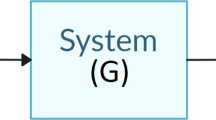Abstract
In this paper, the mixed \(\mathcal {H}_{2}/\mathcal {H}_{\infty }\) model predictive control (MPC) using Nash game approach for linear systems is proposed (Aadaleesan in PhD Dissertation, IIT Guwahati 2011, Aadaleesan and Saha in Proceedings of annual meeting of American institute of chemical engineers. Philadelphia 2008). Two-player game strategy is adopted by using two separate cost functions, viz., \(\mathcal {H}_{2}\) and \(\mathcal {H}_{\infty }\) cost functions for the minimizing and maximizing players of the game, respectively. The problem ultimately reduces to solving a pair of cross-coupled Riccati equations. Although solving the coupled Riccati equations resulting from LQ games is by itself of theoretical importance, in the present work it has been extended, for the first of its kind, to the regime of receding horizon control. Numerical examples are provided for disturbance rejection case to check the efficiency of the present algorithm against another established robust MPC (Orukpe et al. in Proceedings of American control conference. New York, pp 6147–6150 2007).



Similar content being viewed by others
Notes
\(f^*\) represents the optimal value of f.
At steady state \(x_{k|k}=x_{k+1|k}\) and hence \(P_{k}^{(.)}=P_{k+1}^{(.)}\).
Solving the coupled non-symmetric difference Riccati equations from a finite horizon LQ game, even numerically, is intractable.
References
Orukpe PE, Jaimoukha IM, El-Zobaidi HMH (2007) Model predictive control based on mixed \({\cal H}_2/{\cal H}_{\infty }\) control approach. In: Proceedings of American Control Conference. New York, pp 6147–6150
Kothare MV, Balakrishnan V, Morari M (1996) Robust constrained robust model predictive control using linear matrix inequalities. Automatica 32:1361–1379
Bernstein D, Haddad WM (1989) LQG control with an \({{\cal H}}_{\infty }\) performance bound: a Riccati equation approach. IEEE Trans Autom Control 39:293–305
Bouyer P, Brenguier R, Markey N, Ummels M (2012) Concurrent games with ordered objectives. In: Proceedings of the 15th international conference on Foundations of Software Science and Computation Structures (FoSSaCS’12). Tallinn, pp 301–315
Ning G, Tie L, Cai KY, Wu XY (2012) Nash equilibrium solutions of tracking game for bilinear systems with exponential reference signals. Optim Control Appl Methods 34:608–622
Vamvoudakis KG, Vrabie D, Lewis FL (2012) Adaptive optimal control algorithm for zero-sum nash games with integral reinforcement learning. In: Proceesings of AIAA Guidance, Navigation and Control Conference. Minneapolis, p 4773
Limebeer DJN, Anderson BDO, Hendel B (1994) A Nash game approach to mixed \({\cal H}_2\) and \({\cal H}_{\infty }\) control. IEEE Trans Autom Control 39(1):69–82
Freiling G, Jank G, Abou-Kandil H (1999) Discrete-time Riccati equations in open-loop Nash and Stackelberg games. Eur J Control 5:56–66
Jacob E (2005) LQ dynamic optimization and differential games. Wiley, New York
Aadaleesan P (2011) Nash game based mixed \({\cal H}_{2}/{\cal H}_{\infty }\) model predictive control applied with Laguerre-wavelet network model. PhD Dissertation, IIT Guwahati
Aadaleesan P, Saha P (2008) Mixed \({\cal H}_{2}/{\cal H}_{\infty }\) model predictive control for unstable and non-minimum constrained processes. In: Proceedings of annual meeting of American Institute of Chemical Engineers. Philadelphia
Freiling G (2002) A survey of nonsymmetric Riccati equations. Linear Algebra Appl 351–352:243–270
Freiling G, Ionescu V (1999) Nonsymmetric discrete-time difference and algebraic Riccati equations: some representation formulae and comments. Dynam Systems Appl 8:421–437
Chen X, Zhou K (1998) \({\cal H}_{\infty }\) Gaussian control design. In: Proceedings of the 37th IEEE conference on decision and control. IEEE Control Systems Society, Piscataway, New Jersy, pp 638–643
Simaan M, Cruz JB Jr (1973) Sampled-data Nash controls in non-zero-sum differental games. Int J Control 17(6):1201–1209
Başar T (1989) A dynamic games approach to controller design: disturbance rejection in discrete time. In: Proceesings of 28th- IEEE Conference on Decision and Control. Florida, pp 75–84
Başar T, Olsder GJ (1999) Dynamic noncooperative game theory. SIAM, Philadelphia
Higham NJ (2002) Accuracy and stability of numerical algorithms. SIAM, Philadelphia
Aadaleesan P, Saha P (2016) A Nash game approach to mixed \({\cal{H}}_{2}/{\cal{H}}_{\infty }\) model predictive control: part 2–stability and robustness. Int J Dyn Control. doi:10.1007/s40435-016-0259-5
Benzaouia A, Hmamed A (1993) Regulator problem for linear continuous-time systems with nonsymmetrical constrained control. IEEE Trans Autom Control 38(10):1556–1560
Benzaouia A, Burgat G (1989) Existence of non-symmetrical Lyapunov functions for linear systems. Linear Algebra Appl 121:217–231
Freiling G, Lee SR, Jank G, Sarychev AV (1996) Sufficient conditions for the existence of open loop Nash and Stackelberg strategies. In: Proceedings of controlo’96. Porto, pp 121–126
Scokaert POM, Mayne DQ, Rawlings JB (1999) Sub-optimal model predictive control (feasibility implies stability). IEEE Trans Autom Control 44(3):648–654
Abou-Kandil H, Bertrand P (1986) Analytic solution for a class of linear-quadratic open-loop Nash games. Int J Control 43(3):997–1002
Abou-Kandil H, Bertrand P, Drouin M (1986) A closed form solution for discrete-time linear-quadratic games. In: Proceedings of the 4th IFAC/IFORS symposium on large scale systems: theory and applications. Zürich, pp 786–790
Author information
Authors and Affiliations
Corresponding author
Rights and permissions
About this article
Cite this article
Aadaleesan, P., Saha, P. A Nash game approach to mixed \(\mathcal {H}_{2}/\mathcal {H}_{\infty }\) model predictive control: part 1—state feedback linear system. Int. J. Dynam. Control 5, 1063–1072 (2017). https://doi.org/10.1007/s40435-016-0261-y
Received:
Revised:
Accepted:
Published:
Issue Date:
DOI: https://doi.org/10.1007/s40435-016-0261-y




